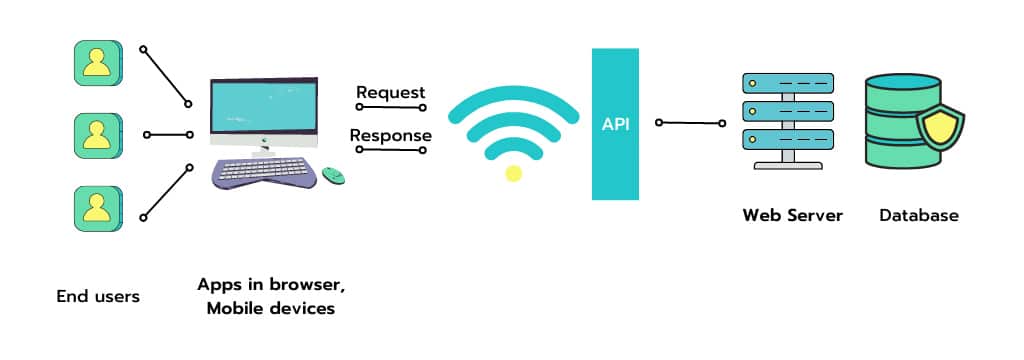Types of API Testing: How to Test Your API in Simple Terms
To put it formally, APIs, or Application Programming Interfaces, allow applications to communication with each other and exchange data. However, to comprehend the API role better, let´s analogize it to a real-life model:
When you come to a restaurant, you interact with the waiter. You can ask for a menu, make an order, or ask for a bill. The waiter plays the role of the interface in your interaction with the restaurant. You are not obligated to comprehend how food is prepared, the ingredients used, or how the restaurant counts a bill. A restaurant accomplishes these functions, and then you receive results with the help of the waiter, who represents the API of the restaurant. You are not involved in intricate details, and there is only interaction between two systems.
In the article below, we will figure out the following:
- What are API and API testing?
- Types of API testing
- What are the benefits and drawbacks of API testing?
- API testing principles
What is API?
At its core, API is a set of protocols, routines, and tools for building software and applications. An API defines how software components should interact and enables communication between systems.
API enables developers to access a platform or application’s features or data without having to know how they were implemented. It allows developers to save time by reusing existing code and building more complex systems by combining various APIs.

What is API testing?
API testing is a type of software testing that determines if the developed APIs meet the expectations for functionality, stability, reliability, and security. It also helps ensure that the API is compatible with other systems and applications that may use it.
The process of API testing helps validate the API functions as expected and can handle the anticipated workload and traffic. It prevents issues that could arise in production, such as slow performance or security vulnerabilities.
API testing is typically performed during development, allowing teams to identify and resolve any issues before the API is released, saving time and reducing costs.
Testing can be automated using testing tools and frameworks. The tests can include functional tests, which check that the API can perform its intended functions, and performance tests, which validate that the API can handle the expected traffic and workload.
Types of API testing
Validation testing
One of the most crucial API tests is validation, which is generally performed at the end of the development process. Validation in API testing aims to confirm a product’s functionality, behavior, and efficiency. It can include testing for the correct handling of edge cases, data validation, and error handling. Validation testing aims to ensure proper development in connection to the specified user requirements and criteria.
Functional testing
Functional testing of APIs includes testing specific codebase features. It involves testing an API’s individual functions or endpoints to ensure they function correctly and meet the specified requirements.
This type of testing focuses on verifying that each function behaves as expected and returns the correct results for a given set of inputs. It is an essential step in the development process, as it helps to identify and fix issues early on, ensuring that the API is reliable and meets the needs of its users.
UI testing
UI testing of APIs refers to testing an application’s graphical user interface (GUI) to verify that the API functions correctly and meets the user’s requirements. The goal of UI testing is to catch any errors or issues in the presentation of the data returned by the API and ensure that it is visually appealing and easy to use for the end-user.
UI testing can be performed manually or through automated testing tools, simulating user interactions and checking for expected results.
Load testing
Load testing of APIs involves testing the API’s ability to handle large amounts of concurrent requests and traffic by sending multiple requests simultaneously and evaluating how the API responds.
There are three levels of API load testing baseline, maximum load, and overload, which entails applying an additional 15-20% to the expected maximum load.
Load testing is performed using various tools and techniques, such as stress testing, spike testing, and endurance testing. This type of testing is critical in determining the API’s performance and stability under real-world conditions.
The load testing results help identify bottlenecks and potential performance issues that may impact the API’s reliability and scalability.
Security testing
The goal of security testing is to identify and mitigate any risks to the API and its users. Security testing helps to ensure that the API is protected against malicious attacks and that user data is secure, considering that in 2020, 95% of APIs experienced at least one security problem, according to SALT.
Security testing also ensures that the API complies with industry standards and regulations, such as OWASP (Open Web Application Security Project), and protects sensitive information such as user data and credentials.
Penetration testing
An API penetration test involves simulating a real-world attack of the hacker with limited knowledge of API to identify vulnerabilities and security weaknesses. This type of testing is performed by ethical hackers who use a variety of tools and techniques to attempt to penetrate the API’s defenses.
The goal of penetration testing is to identify potential security risks and weaknesses that malicious actors could exploit. It includes testing for vulnerabilities such as SQL injection, cross-site scripting (XSS), and cross-site request forgery (CSRF).
Penetration testing also evaluates the API’s ability to detect and respond to security incidents and the overall resilience of the API’s security measures. By conducting penetration testing, organizations can improve the security of their API and reduce the risk of successful attacks.
Fuzz testing
Fuzz testing of APIs, also known as fuzzing, is a software testing technique that involves providing a large and diverse set of inputs to an API to find unexpected or undesirable behavior. It aims to uncover potential security vulnerabilities or other bugs that may not have been detected through different testing methods.
During fuzz testing, the API is subjected to numerous random, semi-random, or specifically crafted inputs to stress the system and uncover potential weaknesses. This technique is often used to find bugs and security flaws in complex systems and to ensure that the API can handle a wide range of inputs without crashing or producing incorrect results.
Runtime error detection
Runtime error detection testing refers to identifying errors that occur when an API is executed or run. These errors can occur for various reasons, such as incorrect input data, bugs in the API code, and compatibility issues with other system components.
Runtime error detection aims to identify and diagnose errors, so they can be resolved and prevent the API from producing incorrect results or failing. It is critical because APIs often serve as the foundation for other software applications, and their correct behavior is crucial for the proper functioning of those applications.
There are several techniques used for runtime error detection in APIs, including:
- Error detection;
- Resource leaks;
- Execution failures;
- Monitoring.
3 Benefits of API testing
API testing benefits include testing an application’s overall quality, security, and functionality. Here are some benefits worth mentioning.
- Language independence
The testing process can be performed using any language because the data is exchanged using XML and JSON formats. These formats can be easily read in many programming languages using in-built libraries. - Early Error Detection & Time-saving
Since API components are usually developed before UI, testing can be run without a GUI. As a result, testing API can be carried out at the early stage of the development cycle, allowing developers to detect and fix problems before they become significant issues. - Lowers cost
Time efficiency and cost reduction go in conjunction. As it was previously noted, API testing has the advantage of detecting problems at the early stage of the SDLC. Thus, it is possible to address the errors before they impact production, which reduces the expense of application updates or the cost of fixing the problem.
Drawbacks of API testing
However, API testing might have some drawbacks, though they don’t have serious repercussions. Still, we will explore them to have a clear understanding.
- Time-Consuming
Automated API testing can be time-consuming to set up and maintain, especially for complex applications. - Complexity
API testing can be complex and requires a deep understanding of the application and its components. This can make it difficult for non-technical stakeholders to understand the testing results. - Limited Testing Capabilities
API testing is limited to the API’s functionality and does not test the user interface or other aspects of the application.
Despite these minor disadvantages, API testing is still an essential part of the development process, as it can uncover hidden bugs and defects and help ensure the overall quality and security of the application.
API testing principles
API testing principles are the fundamental guidelines and best practices that help ensure the quality and reliability of Application Programming Interfaces (APIs). Some of the key principles of API testing include the following:
- API testing should be included in your process of continuous integration and delivery.
- Writing API tests should be simple to maintain and create.
- An API that is designed well will make it simpler to write tests.
- You should test the limits of your system.
- Write tests that are concise and have a specific purpose.
- Make sure your tests are deterministic.
- Run your tests simultaneously to save time.
- Use available tools to make API testing simpler.
By adhering to these API testing principles, organizations can ensure that their APIs are reliable, secure, and meet the needs of their users.
Bottom line
Testing APIs is an integral part of the software development process that ensures the functionality and reliability of the application. It helps to identify any issues before the application is deployed, saving time and resources in the long run.
Various tools and techniques are available for testing APIs, including manual testing, automated API testing, and testing frameworks. The choice of approach will depend on the project’s specific requirements, but it is crucial to implement testing to guarantee a high-quality and user-friendly product. With increasing reliance on APIs in today’s digital world, testing is critical in delivering robust and practical applications.



